Strawberry Rhubarb Jam (for canning!)
This post may contain affiliate links. Please read my disclosure policy.

As Apple Butter is my fall canning comfort, Strawberry Rhubarb Jam is my early Summer equivalent. This delicious fruit preserve is made from the season’s two favorite; one sweet and one tart. It’s my source of nostalgia in warmer weather, as I have fond memories of my grandmothers making dozens of rhubarb recipes each year in their Midwest kitchens.
Strawberry Rhubarb Jam is loved in our house for its perfect balance of sweet and tangy flavor, making it very versatile and bright.The sweetness of strawberries with the tartness of rhubarb result in a well-balanced and flavorful jam, simmered with vanilla bean for extra depth. It’s such a vibrant red color, too! Eating it with buttered biscuits is my favorite, as well as on yogurt or ice cream, toast, as a cheese board accompaniment, and a tasty topping to sourdough discard pancakes.
What Makes this Strawberry Rhubarb Jam Special?
When developing this jam recipe, I wanted the fruit to shine and be the perfect sweetness.
- As we often macerate fruit with sugar for some time to bring out the juices for pie making, it does something incredible for jam, too: the foaming that occurs when this jam was being made dissipated quite quickly and no skimming was needed! This is because of osmosis. As the sugar works its way into the fruit, excess air and moisture leak from the fruit, which forms a bit of natural syrup around the fruit chunks. When we macerate the fruit ahead of time, it cuts down significantly on the foaming action of the jam as it cooks, since the foam is caused by the release of air from the cells of the fruit as it boils.
- By macerating the fruit, the true flavors of the strawberry and rhubarb are elevated. Combined with vanilla bean, this is a gourmet tasting jam that you can make at home!
- This jam sets beautifully without the use of commercial pectin in about 30 minutes on the stove. That’s right; just the fruit, sugar, and lemon juice can make this happen. But they are all equally important, so do not deviate from the amounts called for in the recipe. The science of this is below.

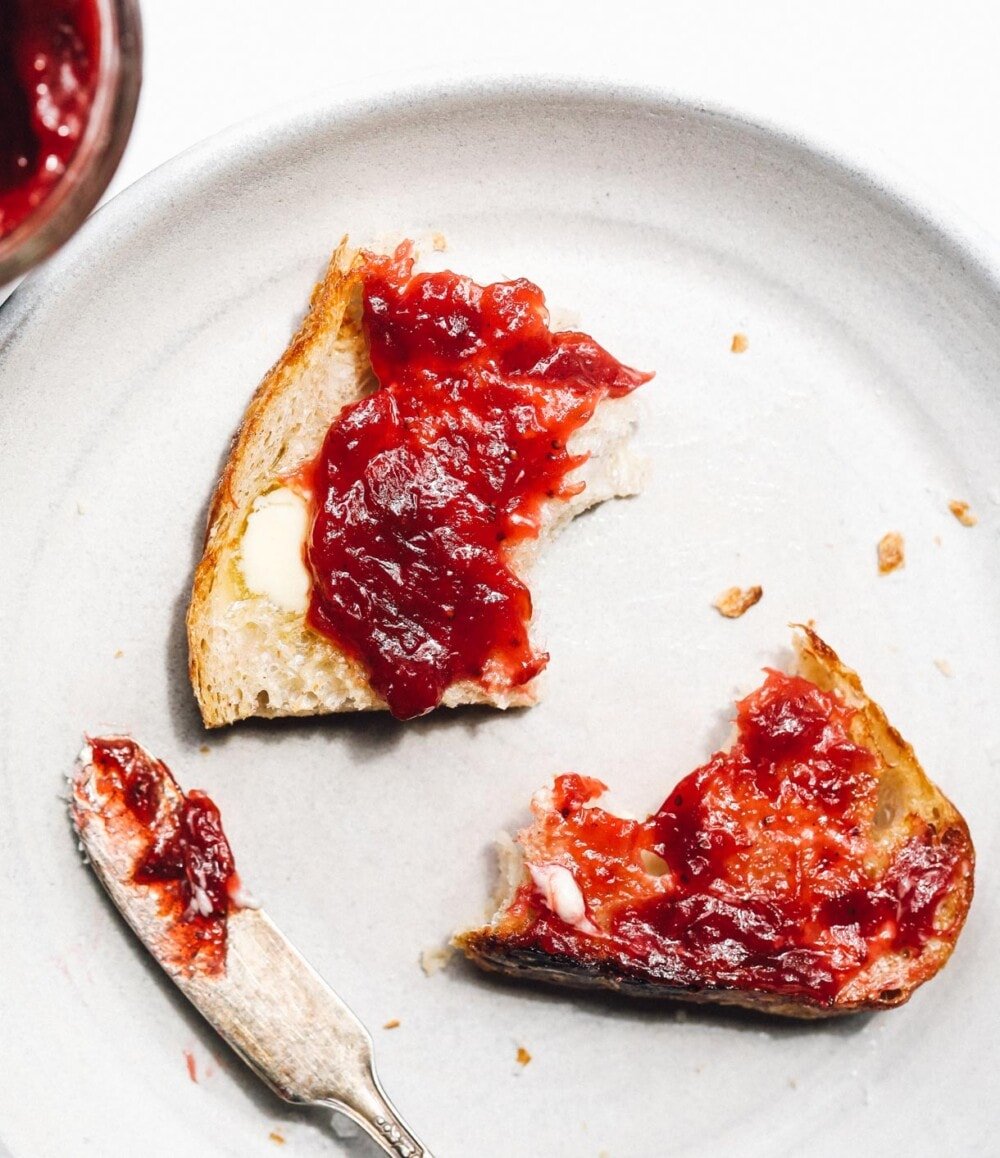
How Do You Thicken Jam Without Using Pectin?
When using low-pectin fruits like strawberries and rhubarb, it’s common to use commercial powdered pectin to help the jam set faster and easier. However, I find that sometimes jams made with powdered pectin need so much sugar that they cover up the true flavor of the fruit, so I relied on lemon juice (the acid), heat, and sugar to thicken this strawberry rhubarb jam naturally.
Pectin is a type of starch, called a heteropolysaccharide, that occurs naturally in the cell walls of fruits and vegetables giving them structure. It is more present in slightly unripe fruits and degrades as the fruit ages.
When combined with sugar and acid over heat, pectin makes jams and jellies develop a semisolid texture when they cool. Acid helps to draw the pectin from the fruit as it simmers, and simmering evaporates some of the moisture and concentrates the pectin.
Although strawberries and rhubarb are naturally high in acid, they are low in pectin. However, they cook down to a lovely, thick consistency all on their own, without any added pectin using the easy tricks in this recipe.
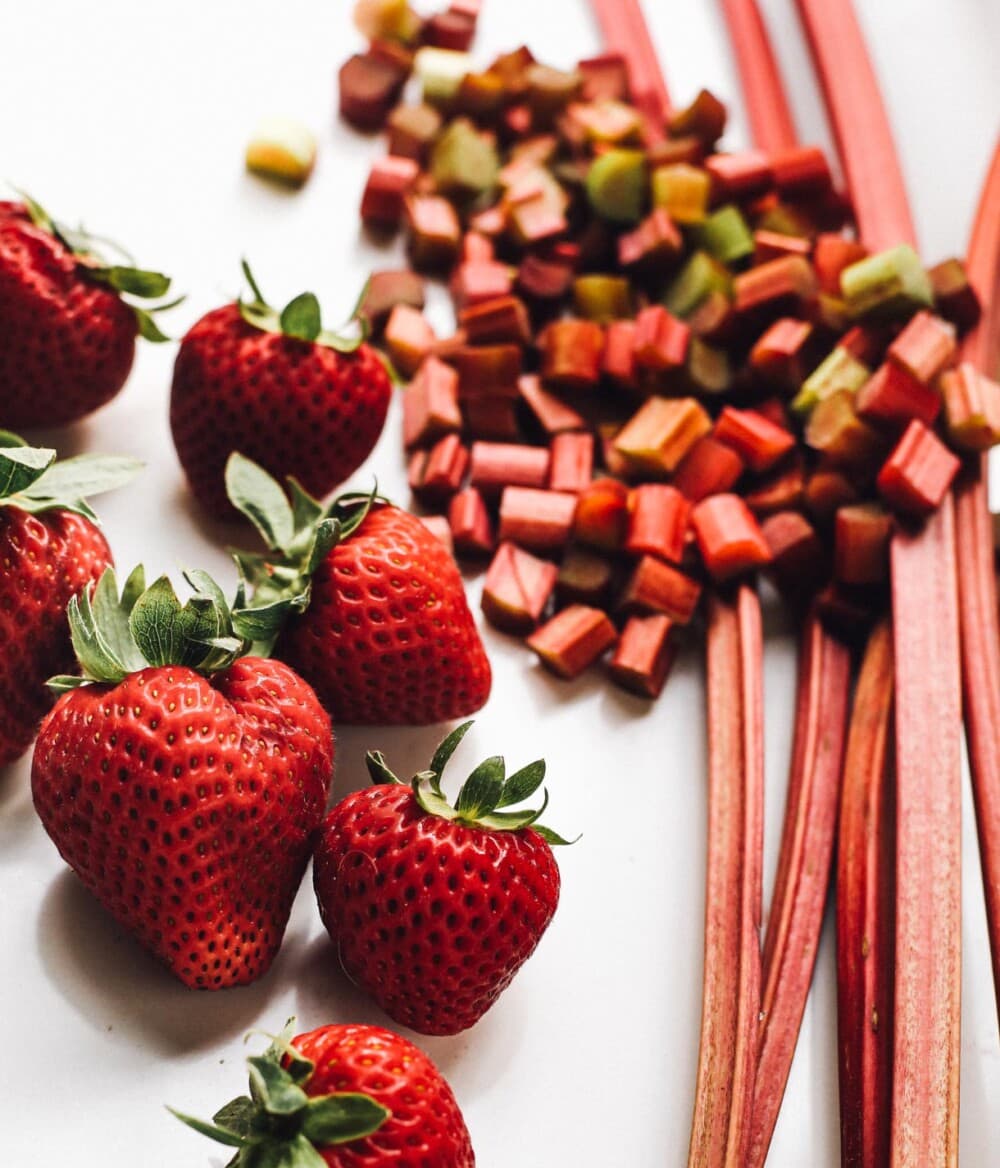
Ingredients for Homemade Strawberry Rhubarb Jam:
- rhubarb
- strawberries
- sugar
- lemon juice
- vanilla bean
- salt
The Important Role of Sugar in Jam Making
Sugar isn’t used just to add sweetness to jam or jelly. It always seems like a lot of sugar to add, but the truth is that the ratio of sugar is crucial to the pectin set, shelf-stability, color, and flavor of the finished jam. It is a very important ingredient to ensure the preservation of the jam, preventing it from oxidation and creating a web of chemical bonds that prevent air and water from entering. Fascinating!

How to Can Strawberry Rhubarb Jam:
- Mix the strawberries, rhubarb, and sugar in a large bowl and refrigerate overnight.
- The next day, start by sterilizing your jars with warm soapy water and let them dry.
- Have your jar lifter, towel, funnel, and spatula within your reach.
- Put your clean jar in your water bath canner, and heat them to a simmer. You’ll want the warm jam going into warm jars.
- Then you’ll make the jam as instructed in the recipe, and when ready, fill each warm jar with hot jam, keeping 1/4 inch headspace.
- Screw the lids on until finger tight, and put jars back in the water bath canner. Once you’ve filled all jars, bring the water in the canner to a boil.
- Process for 10 minutes, then turn heat off and leave jars in canner for 5 minutes before removing. Let fully cool on counter and let them seal.
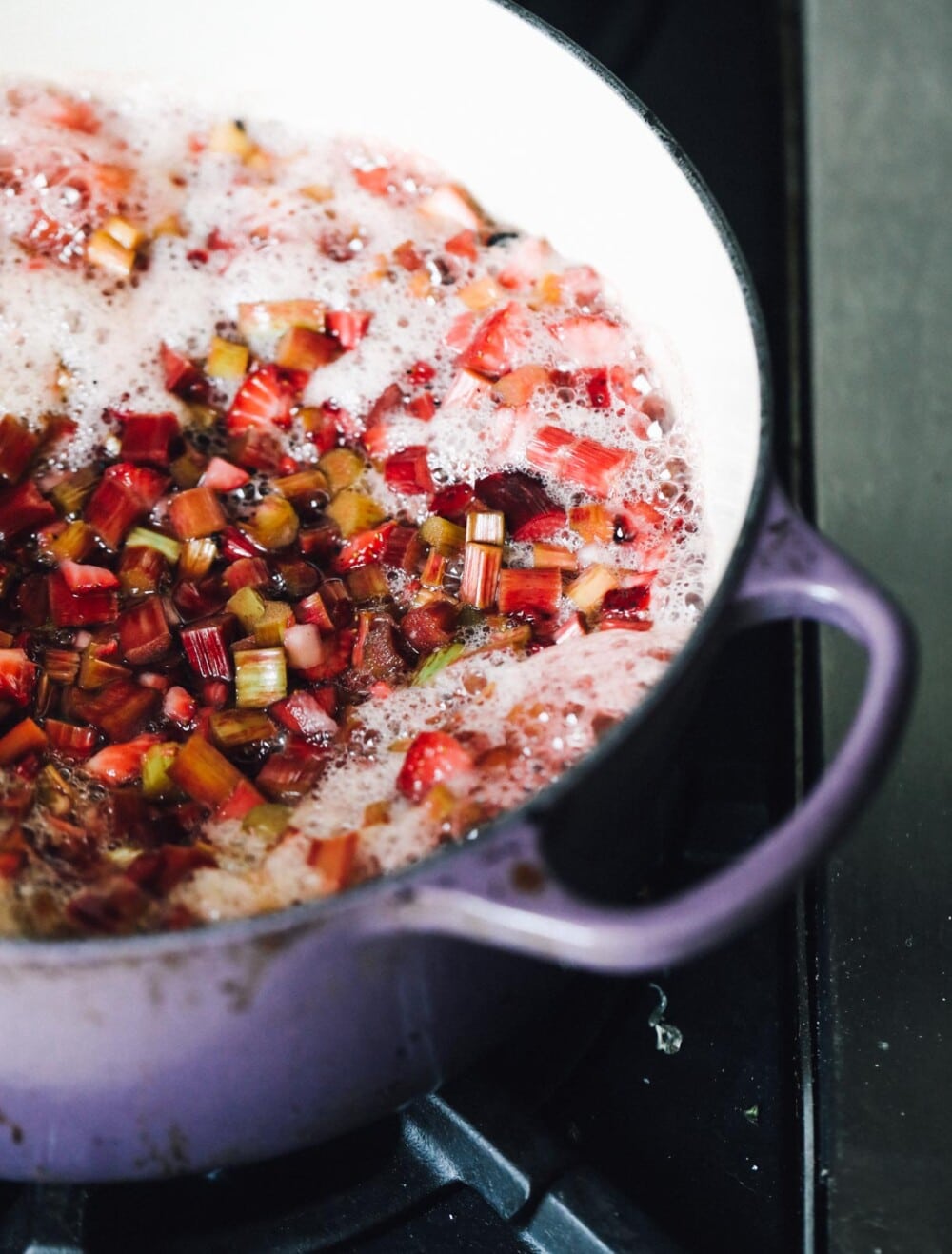
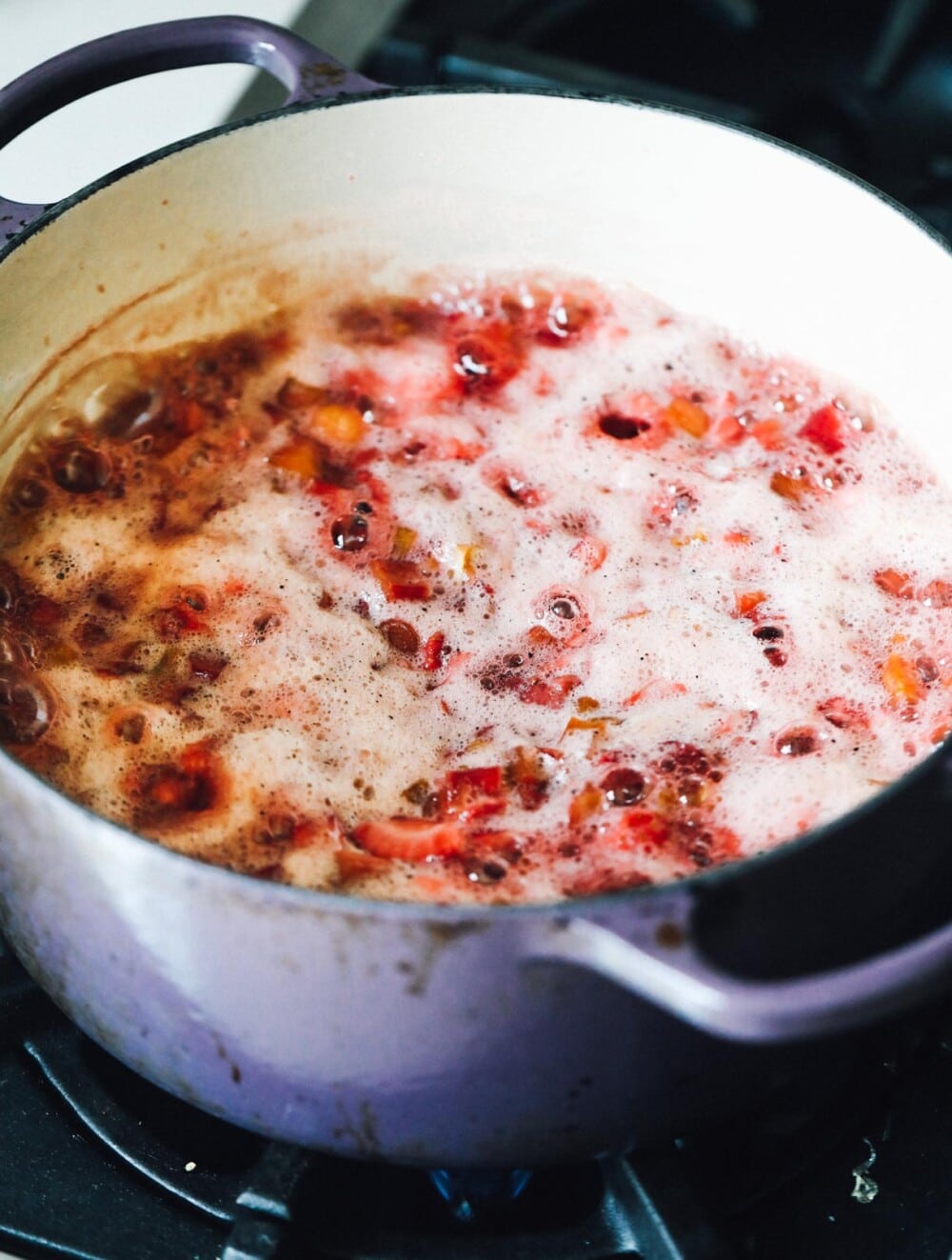
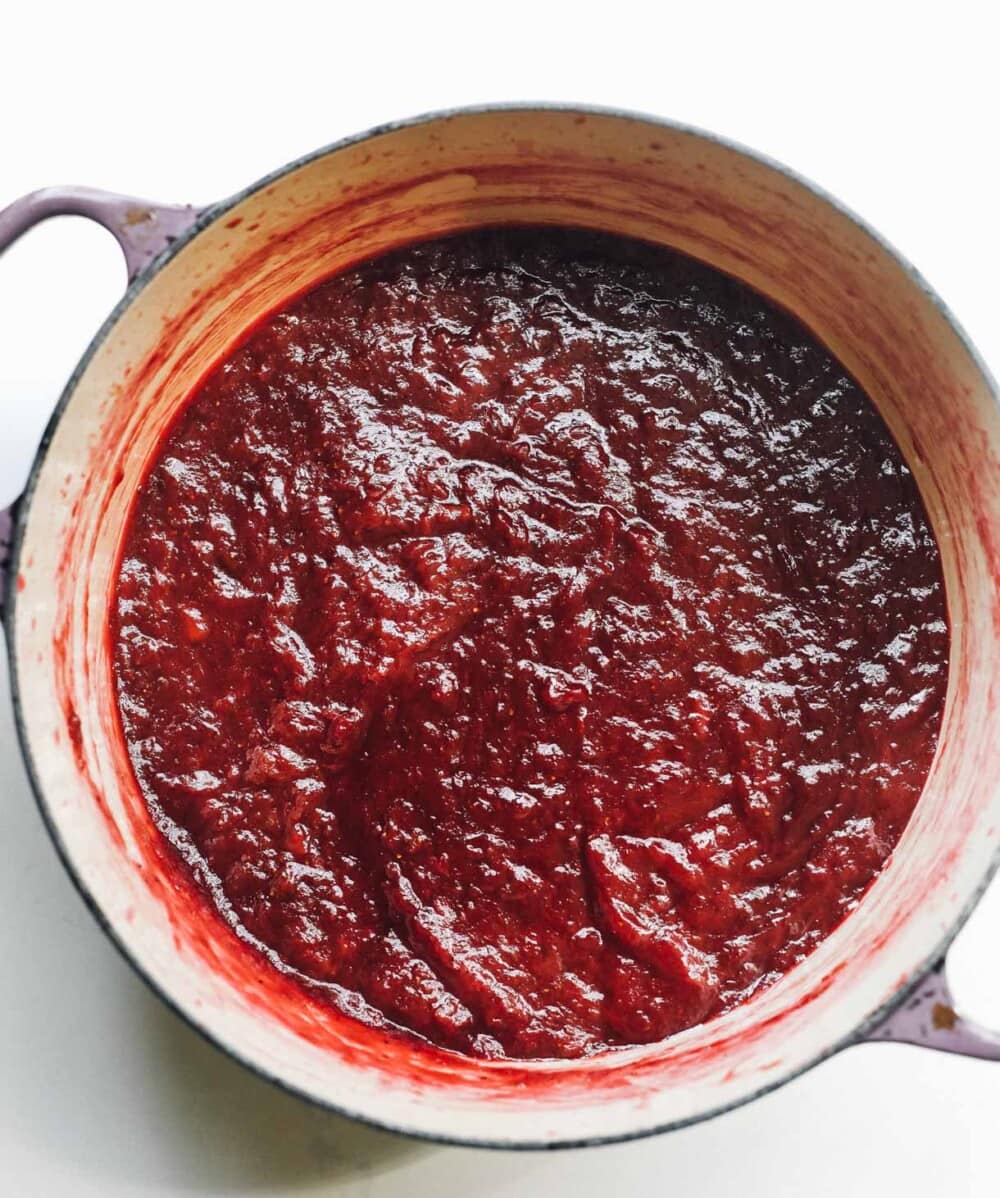
How do I know if my canning jars sealed?
When you inspect lids for seals after the 24 hours, there should be no flex when the center is pressed. Remove the bands and attempt to lift lids off gently with your fingertips. Properly sealed lids will remain attached. If a lid fails to seal within 24 hours, immediately refrigerate the product.
Delicious Uses for Rhubarb Jam:
- Always on sourdough bread! With butter, ricotta, or as a peanut butter and jelly.
- Spread onto flaky, buttery biscuits
- As a topping for oatmeal or yogurt
- A topping for vanilla rice pudding
- Make an ice cream sundae with it, and crushed pistachios
- Make a jam vinaigrette
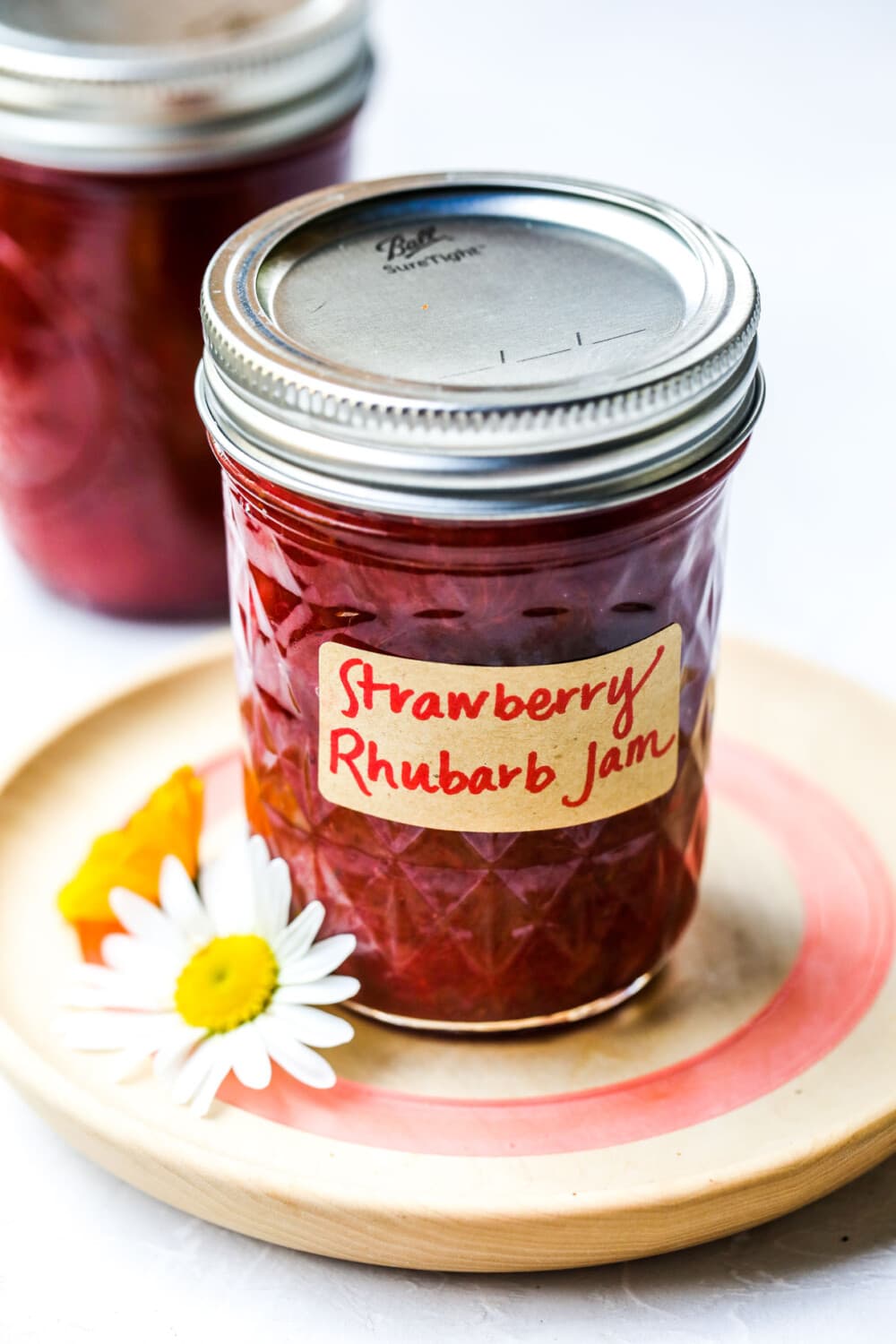
More Canning Recipes:
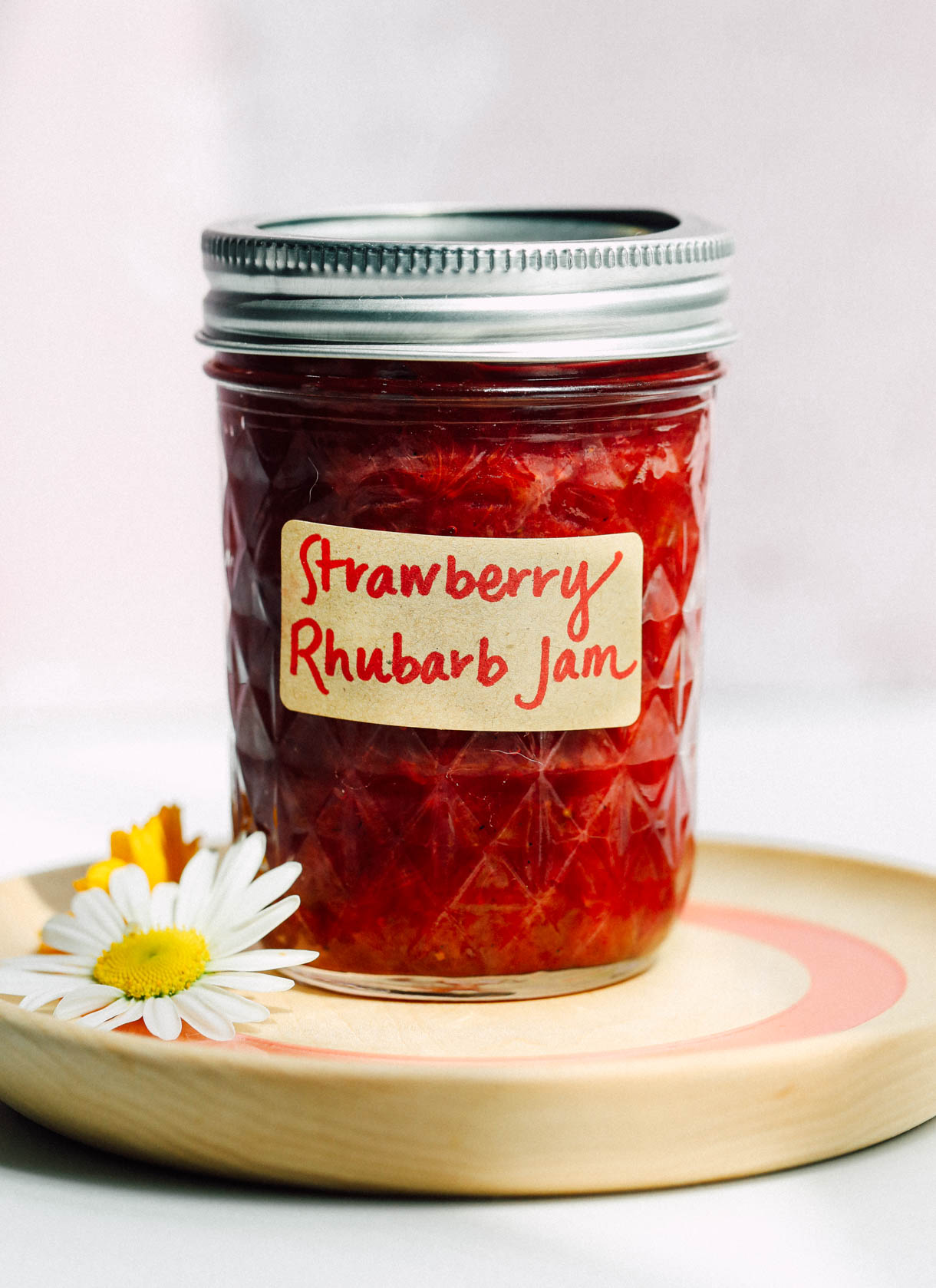
Best Strawberry Rhubarb Jam (for canning!)
SCALE:
Ingredients
- 2 pounds rhubarb, cut into 1/2 inch pieces
- 1 pound strawberries (not over ripe), stems removed and cut into 1/4 inch pieces
- 2 1/2 cups granulated sugar*
- 3 tablespoons bottled lemon juice (Bottled is used because the acidity is 5%, fresh lemons vary. This is important for the preservation.
- 1/4 teaspoon fine salt
- 1 vanilla bean pod, seeds scraped out
Instructions
- Combine rhubarb, strawberries, and sugar in a large glass bowl. Stir thoroughly to combine. Cover with plastic wrap and refrigerate for at least 12 hours, up to 24. This allows the fruit to macerate and release all of its juices.
- When ready to can, take your fruit out of the refrigerator. Add seeds of the vanilla bean. Prepare your jars by washing them with soapy water. Add them to your water bath canner with the wire rack, and bring to a simmer while you make the jam. This is because you want your jars to be hot when you fill them with jam. Place a small plate in the freezer (this helps to test the set.)
- To make jam, add rhubarb mixture that sat overnight to a large heavy bottomed pot. I like to use my 5.5 quart dutch oven. Add the lemon juice and salt. Bring to a boil over medium high heat, stirring occasionally.
- Once the mixture starts boiling, it will begin to foam. Stir every few minutes, watching the heat. The juices will be simmering rapidly as the jam continues to cook down and thicken, evaporating some of the liquid. Over the next 10 minutes, watch the heat as the jam starts to become more cohesive and the fruit breaks down.
- Towards the 22 to 25 minute mark, the jam will begin thickening even more. (Note, this will also depend on your fruit. If it was a wet harvest, your fruit wil have more moisture and take longer to cook down.) Stir often, scraping the sides to ensure it doesn't burn, and watch your heat. I like to start using a thermometer at this point, aiming getting to 212ish degrees F for this jam to turn out with the lovely thick consistency you see in the photos, but you don't have to use a thermometer. Rather, the jam will slide off the spoon in a sheet, rather than individual droplets when it's about ready. Once you think that your jam has reached its setting point, spoon a bit of the jam on the cold plate from the freezer and tilt it vertically so the jam runs. You are aiming for a slow descent, not a runny mess. If it runs slow, it’s set! You can also let the spoonful of jam sit on the cold plate for 30 seconds and then push it with your spoon or finger. If it doesn't flood back together, just creeps back into the open space, you’ve reached your setting point. If it does not do these things, continue cooking.
- When jam is thickened, take each warm jar out of the water and set on a kitchen towel. Fill with hot jam, leaving 1/4 inch headspace. Screw the lids on until finger tight, and put jars back in the water bath canner.
- Once you’ve filled all jars, return them to the canner and bring the water to a boil with lid on. Process for 10 minutes, then turn heat off and leave jars in canner for 5 minutes before removing.
- Let fully cool on a kitchen towel on the counter, and let them seal. Store in a cool, dark place for 1 year.
Notes
- DO NOT reduce the amount of sugar in this recipe or it will not set. The jam is not too sweet, trust me. The tart rhubarb is the perfect balance.
- It’s OK to halve to halve this recipe, but do not double, as the mixture would need to cook for too long a time, and possibly affect the set of the jam.
Did you make this?
tag @heartbeetkitchen on instagram and hashtag it #heartbeetkitchen



Leslie
April 26, 2024
Can I use a steam canner for this recipe?
Amanda Paa
April 26, 2024
I am not familiar with steam canners, sorry!
Heather
March 14, 2024
Hello, I’m a first time jam maker. Curious as to why you said to put fruit in a “glass” bowl? Does it make a difference compared to a plastic bowl?
Amanda Paa
March 14, 2024
Plastic is fine, I just prefer glass!
Christine
March 9, 2024
Are you able to eat right away or wait the full year
Amanda Paa
March 9, 2024
you can eat it right away!
KarenCB
August 23, 2023
I have frozen strawberries. What adjustments would I make to use your recipe?
Amanda Paa
August 23, 2023
hi karen! i have not tested this recipe with frozen strawberries. sorry!
Laura Fransen
June 27, 2023
I can’t find vanilla beans. Can I substitute vanilla bean paste?
Michelle
August 27, 2023
Made my first batch last night. Wish I had found this sooner! Will definitely be using this recipe with my ever growing rhubarb! Thanks!
Amanda Paa
August 27, 2023
Yay, glad you enjoyed it!
Laura Fransen
June 27, 2023
Can vanilla bean paste be substituted?
Amanda Paa
June 27, 2023
yes, for sure!
Margie
June 26, 2023
Made two batches and this jam came out perfectly each time. Will definitely be a summer staple! Bright slightly tart and not too sugary!
Amanda Paa
June 26, 2023
I’m so glad you enjoyed it, Margie! Thanks for making the recipe.
Ira Rosenberg
June 16, 2023
Made your strawberry rhubarb jam today and it’s wonderful! Tomorrow morning I’ll try it with my homemade sourdough.
Thanks for sharing your recipe.
Amanda Paa
June 16, 2023
That makes my day, so glad you enjoyed it!
Christy DeGrand
June 11, 2023
When do you add the lemon juice and salt?
Amanda Paa
June 11, 2023
Hello! You’ll see that in step 3 in the directions.